3D Truss Models
-
I am still adding advanced options and the edit function to each truss type and floor type. Some are further along than others, but progress is steady.
The manual is currently way down on the todo list, once the plugin matures further it will rise to the top.
With dual pitch hip roofs technically one could have a different pitch for all four sides (the most general case). I should probably try to code this most general case then all the rest simply fall out of it.
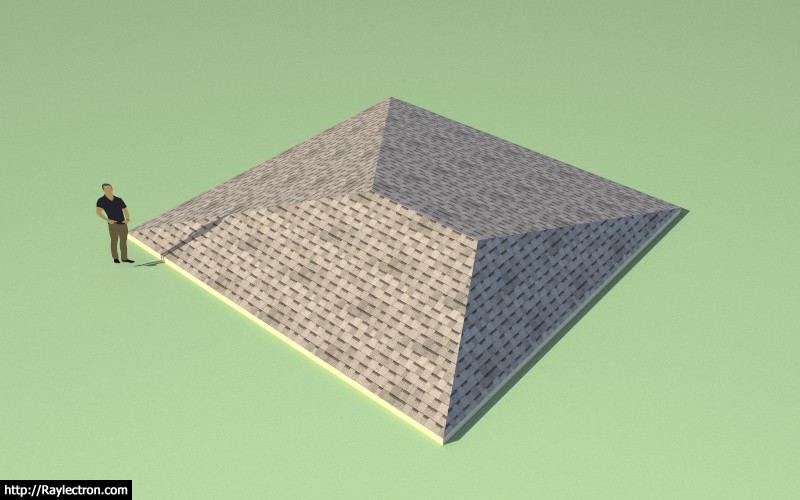
View model here:
3D Warehouse
3D Warehouse is a website of searchable, pre-made 3D models that works seamlessly with SketchUp.
(3dwarehouse.sketchup.com)
-
It is certainly an interesting puzzle. Calculating the commons, jacks and hip rafters is not a problem, I can figure that out. The one item that has me though is the fact that if each pitch is different and assuming the same overhang all the way around and the same birdsmouth cut then the top plate of each wall will need to be slightly different. Again I can make that adjustment for each side of the roof. The real question then is what to do with the birdsmouth cut of the hip rafters? Which wall height does one use?
-
Not exactlly truss house but...

-
Version 2.1.9 - 05.27.2018
- Replaced the 64 bit SketchUp check in the installation module to fix an incompatibility issue with SketchUp 2014.
- Added additional wall cladding materials in the sheathing tab of the global settings.
- Fixed a bug in the top level assembly method of the roof truss module.
-
Version 2.2.0 - 06.19.2018
- Sub-groups within roof and floor truss assemblies can be made persistent by naming these groups or component instances to (custom1, custom2, custom3, etc...), also all other user defined geometry (ie. faces, text, lines and dimensions) are also retained when the assemblies are regenerated by the plugin.
-
I don't have a half hip (rafter roof) setup yet however there is probably a workaround by combining a gable with a hip and then using the trim tool to manually trim some of the rafters, however I haven't really tried this at least not for a real design.
I took about 10-15 minutes and tried creating a half hip with a gable and hip roof as primitives. Using the trim tool made it fairly easy to clean up the rafters, see results here:
3D Warehouse
3D Warehouse is a website of searchable, pre-made 3D models that works seamlessly with SketchUp.
(3dwarehouse.sketchup.com)
Since the end result is not parametric you will want to be sure that you have all of your rafter depths, overhangs etc... set before you dive into the manual editing of such a roof.
This is obviously a painful and slow process. Conclusion, I need to add in a half hip rafter roof.
-
Version 2.2.0b - 09.25.2018
- Fixed a bug so that structural outlookers can be enabled without utilizing a gable end truss.
Technically this should not be allowed since structural outlookers typically require a dropped top chord and currently the only way to achieve a dropped top chord is with a gable end truss (option enabled).
However, since I am not strictly disallowing it I provided some logic so that the appropriate parameters are set so that this particular state is possible. Previously, the gable end truss routine set some required parameters that the structural outlookers were dependent on. Now the outlooker algorithm will set those parameters if they are not previously set by the gable end truss algorithm.
This is a fairly minor fix/patch.
-
Version 2.2.1 - 10.05.2018
- The trim tool now allows for multiple trim operations once a trimming plane is selected.
- Pressing the ESC key will reinitialize the trim tool during multiple trim operations, space bar will terminate.
- The trim tool will now trim components as well as groups.
-
Version 2.2.2 - 10.14.2018
- Name of plugin changed to "Medeek Truss".
- Updated the licensing system to include a 30 day limit of the trial version.
- Updates to the HTML pages of the global settings.
This next week I plan on returning to the multi-pitch hip roof and start back up where I left off a few months ago. I am also going to be adding in the custom material manager so that the truss plugin has the same capabilities as the wall plugin.
After that the next big push is to make all of the rafter roofs parametric with HTML based edit menus similar to the common truss edit menu.
While all this is going on I would also like to complete the stair module of the wall plugin. A lot of things to juggle right now.
-
Version 2.2.2b - 10.16.2018
- Updated the "Edit Truss Assembly" menu so that it properly loads default values when advanced options are expanded.
- Added a user definable name to truss assemblies that will be utilized in the future options and upgrades.
A number of other "under the hood" updates (to numerous to list) were also incorporated to bring the code more in line with the wall plugin and its more efficient and modular organization scheme.
-
Version 2.2.3 - 10.26.2018
- Added a Custom Material Library/Manager in the Materials tab of the Global Settings.
- Enabled custom materials for wall sheathing, wall cladding, roof sheathing and roof cladding in the HTML wall draw and edit menus for common trusses.
- Enabled the ability group materials and control which drop down menu they will appear in.
- Added an SKM file import utility to the Material Library.
- Default wall sheathing and wall cladding materials brought in line with options available in wall plugin.
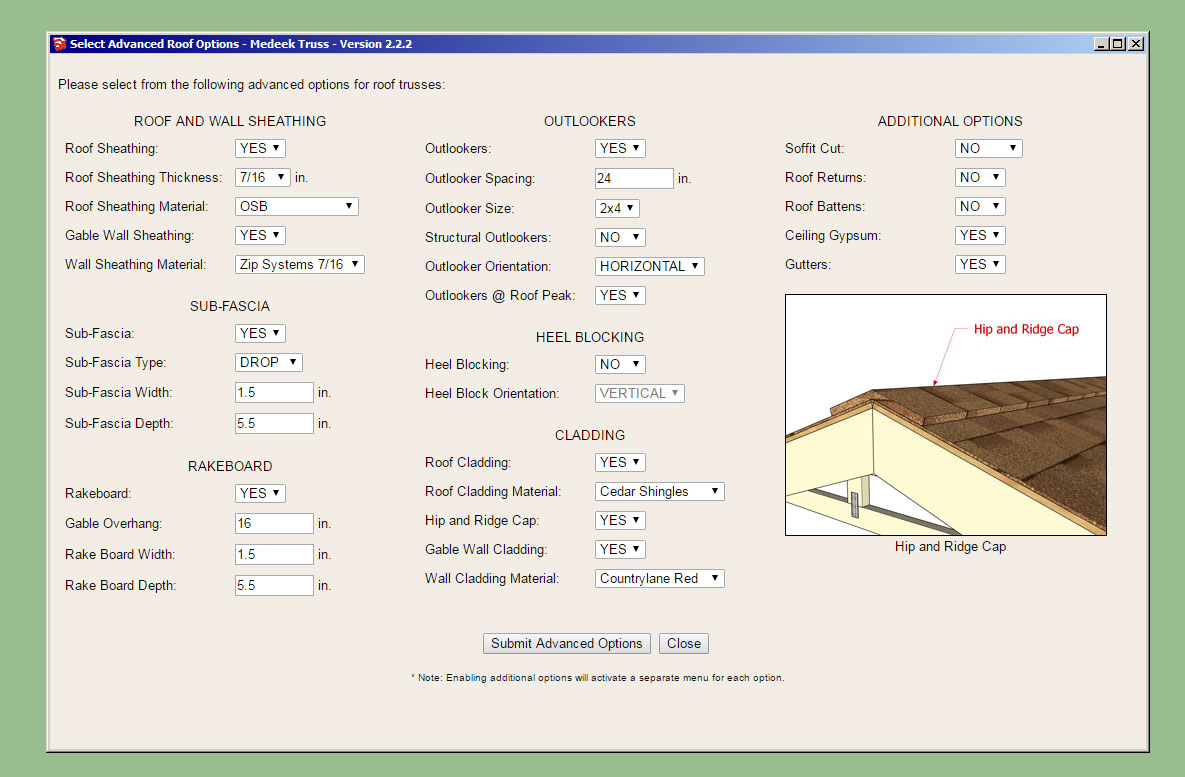
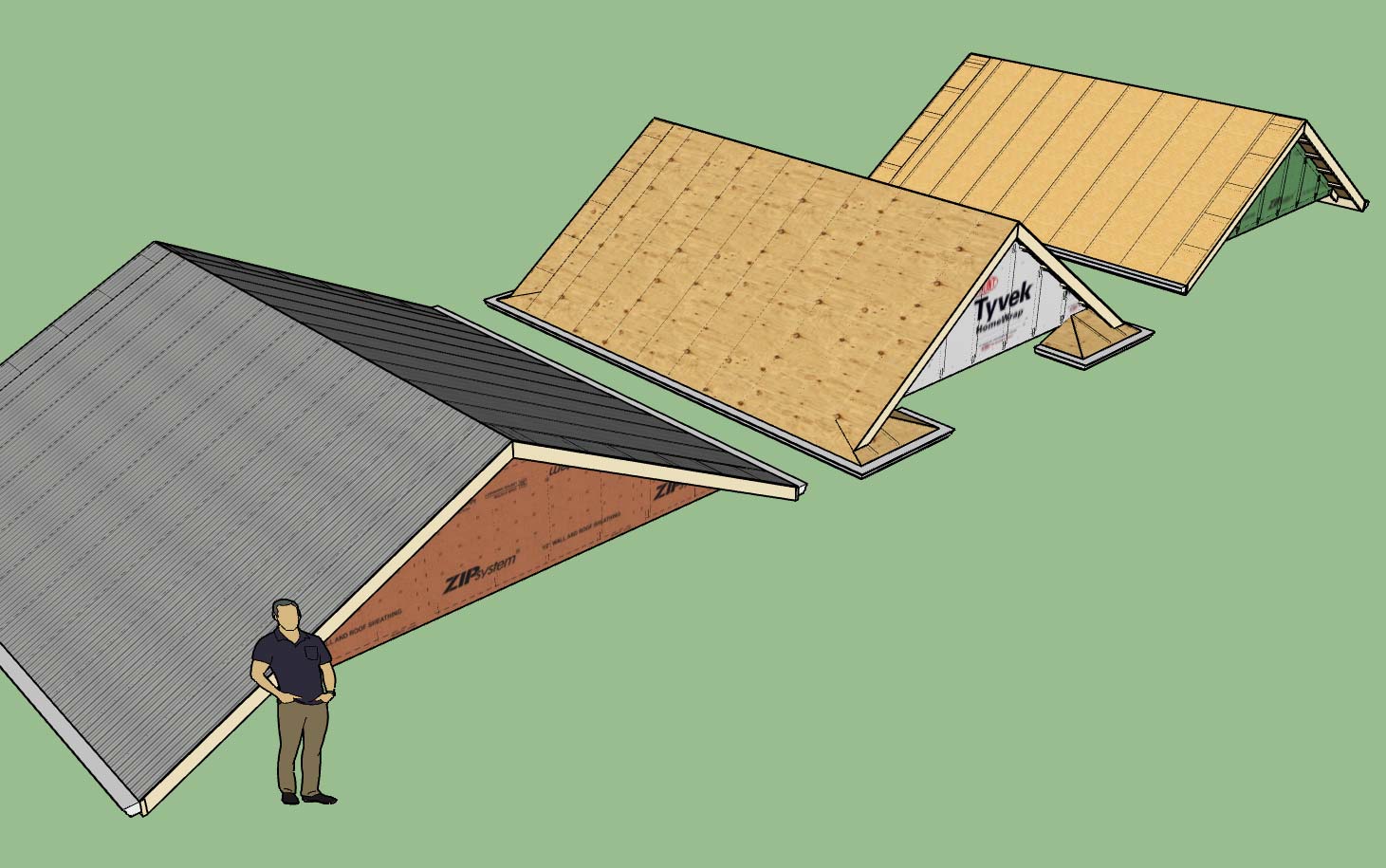
Note the various wall sheathing options that are brought over from the wall plugin (ie. Tyvek, Zip Systems, Plywood, Densglass etc..)
Also note that the custom and expanded materials selection is only available for common truss shapes (ie. common trusses, scissor trusses etc...). I have not yet implemented the new system for other truss shapes and rafter roofs, that is work for yet another day.
There is still a tremendous amount of work that needs to be done with this plugin. Many of the specialty truss shapes do not even have advanced options available to them yet. All I can do is keep hacking away at it and maybe one day I will have the resources to really push this thing along.
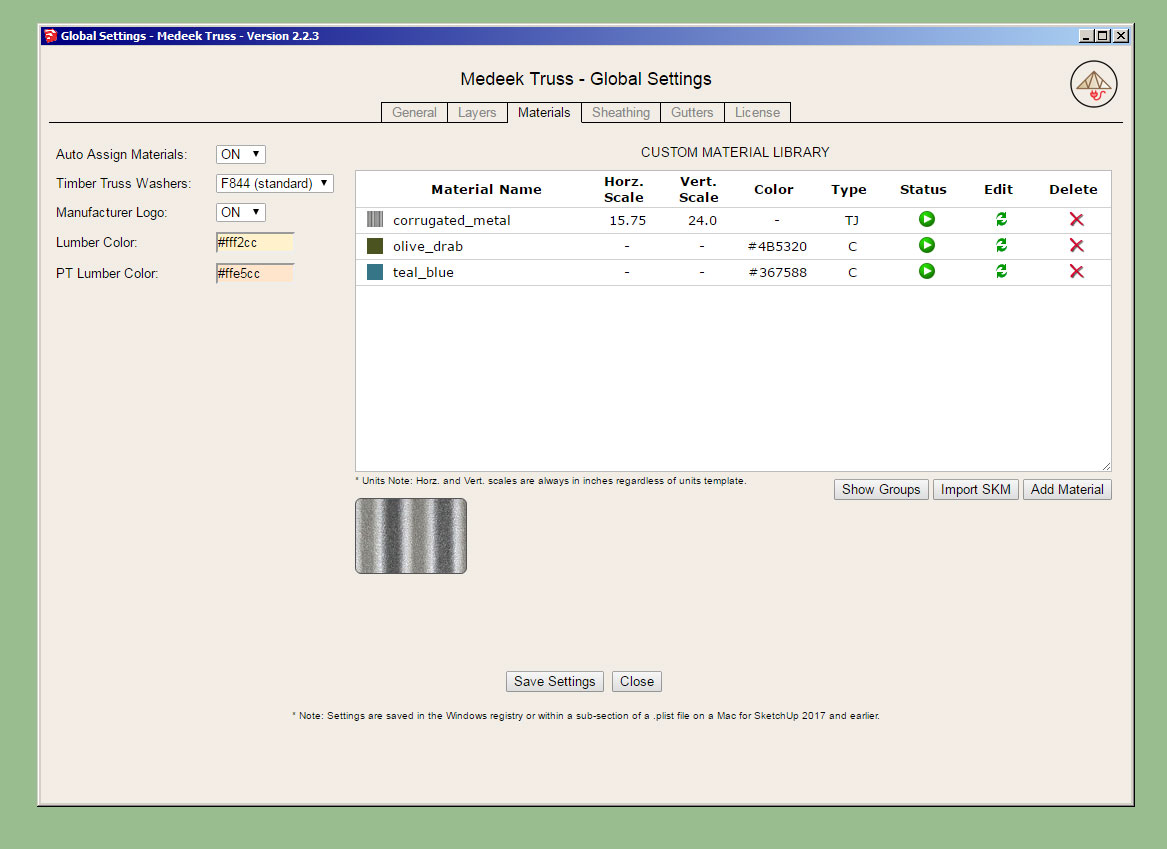
-
Version 2.2.3b - 10.26.2018
- Fixed a bug in the attribute library for common trusses.
-
@juju said:
medeek, it looks like you've started something...
[attachment=0:177uncrq]<!-- ia0 -->can-o-worms.gif<!-- ia0 -->[/attachment:177uncrq]
It's been over three years now and I'm still working on it, seems I've also opened other cans as well, not sure where this all ends, but it's certainly fun.
-
@medeek said:
It's been over three years now and I'm still working on it, seems I've also opened other cans as well, not sure where this all ends, but it's certainly fun.
Thanks for the perseverance and the high grade of scripts.
-
Version 2.2.4 - 11.02.2018
- Enabled wall sheathing, wall cladding, ceiling gypsum and roof cladding for monopitch trusses.
- Enabled gutters and downspouts for monopitch trusses.
- Enabled the "Edit Truss Assembly" function for all monopitch trusses (imperial and metric units).
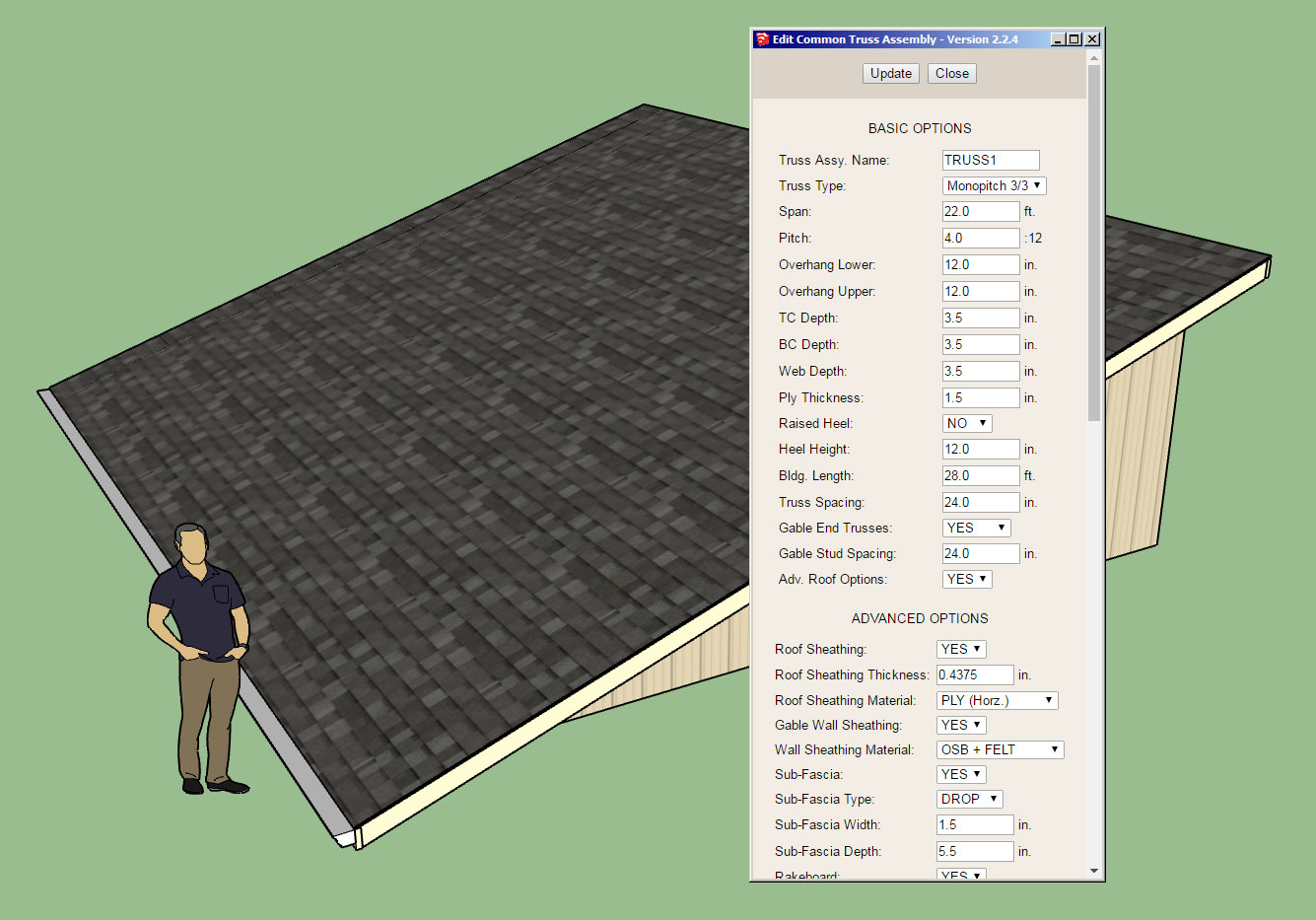
I still need to add a few more advanced options to the monopitch truss type:
- Roof Returns
- Battens
- Soffit Cut
- Heel Blocking
I'm also thinking about adding an insulation option for the ceiling for trusses and rafter roofs so that the truss plugin is up to speed with the wall plugin. Some additional feedback in this regard would be helpful.
With monopitch trusses there is also the issue where the exterior wall corner is created by the truss and hence I need to apply some corner trim on these corners. I will give this some more thought.
-
Version 2.2.4b - 11.08.2018
- Licensee name now appears in the License tab of the Global Settings when plugin is registered.
- Removed all advertising banners from the global settings.
Even though this may appear to be a minor revision it is actually a critical fix/upgrade for users running on Mac and Windows 10.
The advertising banners would only load intermittently and hence would cause the HTML menus to not render (blank white browser window). After giving this some more thought and deciding that the advertising revenue generated by the plugin was not a significant amount, and a less cluttered look is always more appealing, it just made more sense to remove all of it completely.
I've also updated the license tab to be up to date with the Wall plugin's license tab.
This same issue with the advertising banners in the global settings also plagues the Wall plugin. I will be issuing a new revision for it in short order, that strips the advertising from the plugin. I appreciate everyone's patience in this regard.
-
I've recently been thinking about the multi-pitch hip roof again. Eventually I needed to return to this topic since the designer needs the flexibility of assigning different pitches to the various roof planes.
The same issues with multi-pitch hip truss sets applies to rafter roofs as well.
When you have a hip roof situation and the pitches are different on adjacent roof planes yet you want to maintain the same overhang and line up the fascia then the wall top plate must change. However with trusses rather than change the top plate you simply have to raise the heel of the truss on the low side until it equals the height of the adjacent side.
-
Does anyone have any shop drawings of an asymmetric hip truss set they can send me. Specifically I am looking for a hip truss set that has different pitches for front and back and then possibly a different pitch on the ends. I have my theories on how such a truss set should be put together but it is worth the effort to study this a bit further and verify.
-
Tutorial 8 - Trim Function:
View model here:
3D Warehouse
3D Warehouse is a website of searchable, pre-made 3D models that works seamlessly with SketchUp.
(3dwarehouse.sketchup.com)
I've really got to get complex roof framing figured out. The workaround does work (per the video), but who really wants to work that hard? My inherent laziness is what drives me to create these tools, which in turn help not only myself but everyone else who would rather spend 5 minutes designing a roof rather than 4 hours.
I would rather be spending that time playing a game of chess, cooking a good meal or watching a show with the wife.
-
Version 2.2.5b - 12.10.2018
- Added the Extend function for (solid) groups and components. This function allows the user to extend a member to a single plane/face.
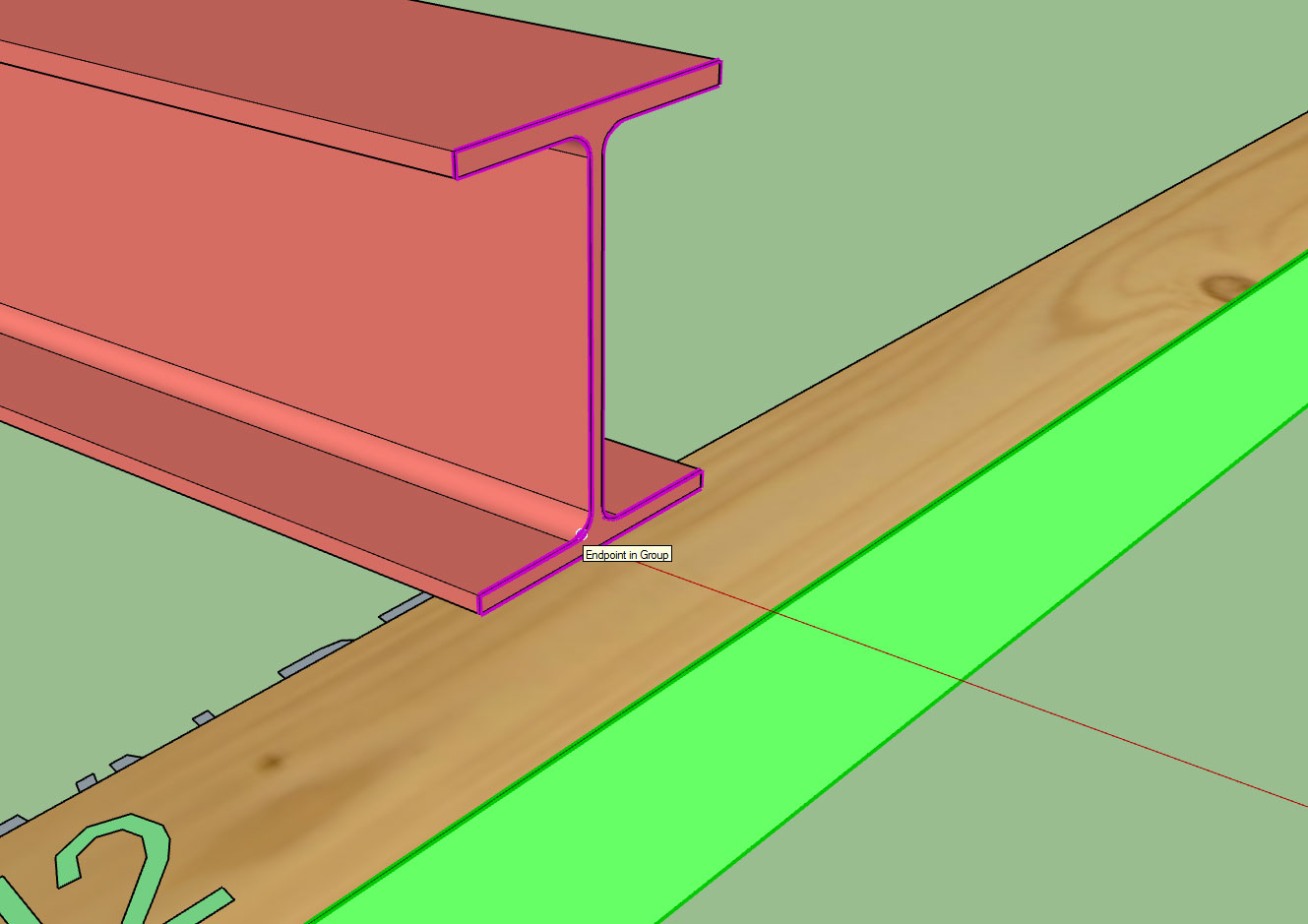
The tool also has the ability to handle fairly complex, prismatic beams etc...
A huge shout out to ThomThom and John (John_DrivenuptheWall) from the SketchUp forums for helping me sort some of the issues out with the algorithm and code.
Tutorial 10:
Advertisement








